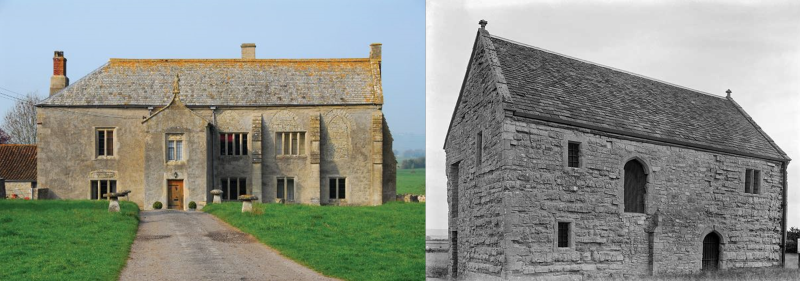Meare and the Abbey

Meare Manor / Meare Fish House – Red Kite Environmental / English Heritage
The link between the church and the wetlands of the Avalon Marshes was possibly forged as early as 670AD when Glastonbury Abbey is said to have been given the manor of Meare by the King of the West Saxons. Much of the rest of the area was owned by the Dean of Wells, who was lord of Wedmore, and the Bishop of Bath and Wells, who was lord of Wookey.
Men of God?
These men of God did not live in peace with each other, as the moorland was a valuable asset that they were prepared to fight over. The dispute became so heated that the Pope was forced to appoint judges to arbitrate in 1202, but the conflict continued with much violence.
In 1326 an attempt at peace was followed by the deliberate burning of the moors south of Meare and the Bishop excommunicating the Abbot and four of his servants and monks who had allegedly destroyed buildings and stolen some of the Bishop’s property. An agreement was eventually reached in 1327 with ownership demarcated by ‘Bounds Ditch’, a bank and ditch (now the district boundary between Westhay and Mudgley).
Meare Pool and the Fish House

Drawn by Red Kite Environmental
The marshes were used for fishing, fowling and for the common grazing of stock. Alder and oak woods were used for their building timbers. Peat was cut for fuel and reeds were harvested for thatching. The greatest wealth was generated by the fishery on “Meare Pool”, a huge lake north of Meare island.
Fish formed a very important part of the monastic diet and a boat was sent weekly from Glastonbury Abbey to Meare to collect fish and daily in Lent when the eating of other meat was prohibited. Over 5,000 eels were caught in Meare Pool every year. A record of 1553 also mentions “great abundances of pykes, tenchards, roches and jeles [eels] and divers other kindes of fishes”.
To the south of the Pool a fish house, manor complex and church were built in the early 14th century, probably by Abbot Adam of Sodbury. The Manor house included a large hall, chapel, chamber, accommodation for clerks and monks and a fortified courtyard; beside it was a vineyard, orchards and fish ponds. The Fish House provided accommodation for the head fisherman with a hall, bedroom and toilet on the first floor and kitchen and store rooms below. There was also a boathouse and a building for the fishermen to drink in.
The “new” Brue
The wetlands were altered considerably by their ecclesiastical lords. The rivers Sheppey, Hartlake and Brue were all diverted and canalised into Meare Pool from their former course into the Axe valley. The “new River Brue” was cut westwards to the sea. Parts of the marshes were enclosed and drained which greatly increased their worth. In the main they remained open and unenclosed for several more centuries until sweeping changes brought about by parliamentary acts created the present day landscape.
The churches ownership and influence over the Avalon Marshes came to an end in 1539 with the dissolution of the monasteries by Henry VIII. This was a very visible end with Abbot Richard Whiting being hanged on Glastonbury Tor!
The island today
The island of Meare is well worth a visit. The attractive Manor House, Fish House and church still exist. You can walk along the “new” River Brue and look across what was Meare Pool (winter flooding can, to some degree, recreate the impression of a vast pool). Look on a map and you will see the long, narrow “tenement plots” which possible date from the 10th century. Walk down Meareway which is the back lane to Westhay, and you will pass squatters houses and the sites of the Meare lake villages (look out for the hummocks in the field). Meare is on our Reserves and Lake Villages cycle route.

Credits and more information
- Text adapted from Richard Brunning’s book “Wet and Wonderful – The Heritage of the Avalon Marshes”
- To learn more about Glastonbury Abbey go to the history section of their website.
- If you would like to learn more about the history of Meare we would recommend Professor Stephen Rippon’s paper “Making the best of a bad situation? Glastonbury Abbey, Meare, and the Medieval Exploitation of Wetland Resources in the Somerset Levels”
Find out more about the heritage of the Avalon Marshes
Somerset’s Avalon Marshes landscape is perhaps best known for peat and water. These give the marshes their special character and have left a wonderful legacy of history and archaeology. For thousands of years people have been drawn to the area; once for food, fuel and safety; now for relaxation, wildlife and heritage.
Heritage Sweet Track